The first prototype of I-153 (c/n 5001)
was equipped with a 750-hp M-25V engine and made its first
flight in August 1938, piloted by Aleksandr I. Zhookov.
The plane was an evolution of I-15bis, that reverted to the gull wing of the I-15 to spare weight and drag compared to the traditional upper wing of its predecessor. The main innovation was the retractable landing gear.
It was suggested that its designation could have been TsKB-3ter (from the latin tertium, third) but this looks unlikely because these designations were not longer utilized in 1938.
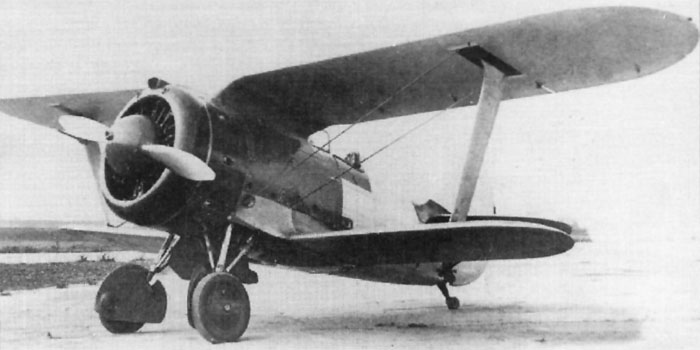
Compared to successive production planes, the first prototype is visually characterized by:
- an I-15bis style spinner
- a fixed pitch propeller
- the lack of the shutter plate, leaving the engine well visible
- the different position of the oil cooler outlet on the left side
- wider elevators
On this image, the plane is still unpainted and unmarked; the fabric surfaces are painted with AII aluminum, while the color of the metal parts is still unclear, perhaps some dark green.
(From Red Stars n.6- Polkarpov biplane fighters)
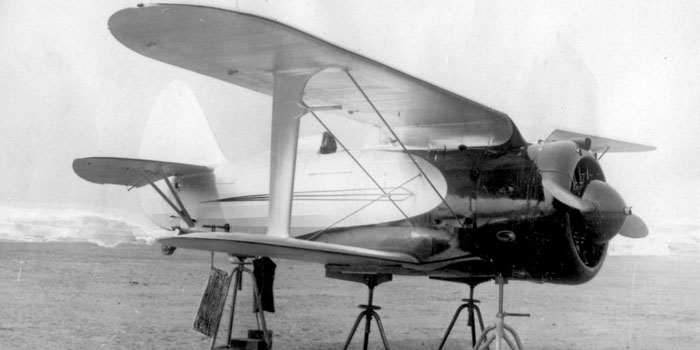
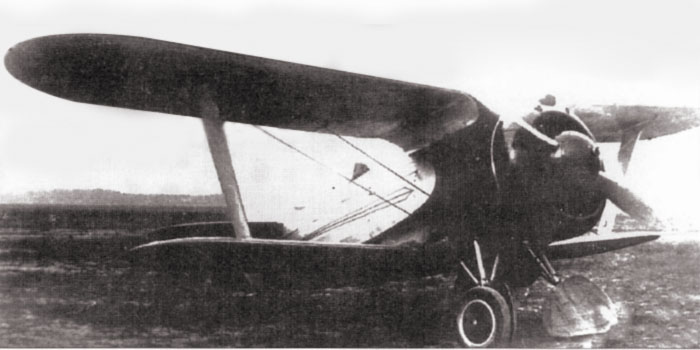
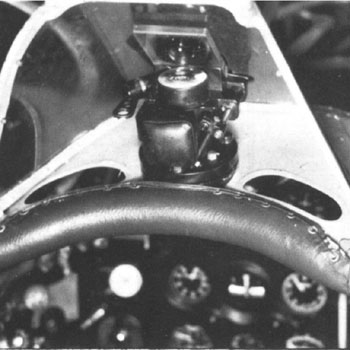 The
first prototype after having painted with a livery, presumably red and
silver, without nationality marks.
The
first prototype after having painted with a livery, presumably red and
silver, without nationality marks.
The factory tests in october 1938 revealed a lot of defects that were corrected in the following planes.
(From Red Stars n.6- Polkarpov biplane fighters)
Right: the I-153 abandoned the OP-1 telescopic gun sight of the I-15bis in favor of a PAK-1 reflection one.
Since 1937, the standards of painting the Soviet military planes included these types of paints:
- AE-x paints were oil enamels for external metal surfaces, resistant to atmospheric agents; they usually were utilized on a layer of ALG-1 yellowish primer, but could be utilized on unprimed metal too;
- AII (or A 2nd) colors were nitrocellulosic lacquers; they could be utilized on wooden and fabric surfaces, primed by a layer of yellowish nitro putty and/or aluminum paint, and on metal surfaces over some primer (usually ALG-1 zinc-chromate yellowish paint).
 AE-9 gloss light gray (for metal skinned surfaces) and AII light gray
(for wood/fabric of some types)
AE-9 gloss light gray (for metal skinned surfaces) and AII light gray
(for wood/fabric of some types)
 AII aluminum (for fabric-skinned surfaces)
AII aluminum (for fabric-skinned surfaces)
Then pre-production planes were produced in October 1938 at Factory n.1. They still retained the M-26V engine, considered only as a gap-filler waiting for the more advanced M-62.
Their look was similar to the later production planes, apart for the I-153 style spinner and fixed-pitch propeller.
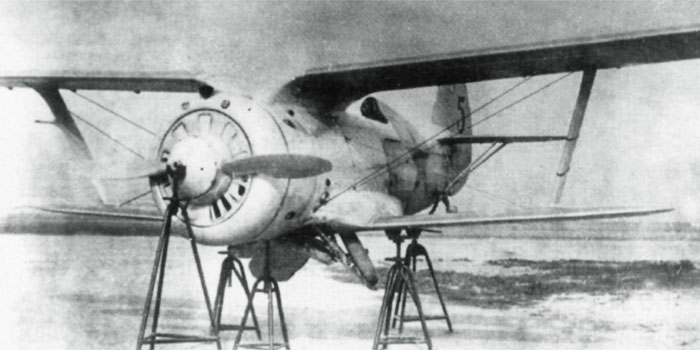
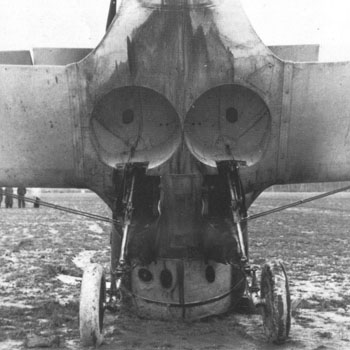 The
second prototype 'black 5' (c/n 6005) tested for landing gear retraction.
It was part of the pre-production batch.
The
second prototype 'black 5' (c/n 6005) tested for landing gear retraction.
It was part of the pre-production batch.
State tests were conducted from March to June 1939 by test pilot Pavel Va. Fedrovi
The plane appear identical to the production planes for its being painted with AE-9 light grey on metal parts and AII aluminum on fabric-covered parts.
From available photos, the red star looks without the thin black circle characterizing the production I-153s.
The I-15bis style spinner visible here looks painted grey and white. It was not utilized on production I-153s.
(From Red Stars n.6- Polkarpov biplane fighters)
Right: the bays of the new retractable landing gear, photographed on a damaged production plane.
The M-25V engine was replaced on the production planes by the similar, but more powerful, M-62 with an output of 800 hp.
After some tests with many types of propellers and spinners, it was adopted a variable- pitch AV-1, usually without any spinner. Some of these tests were made on the battlefield against Japaneses in Mongolia, where the type had its baptism of fire.
About 3018 I-153s M-62 were built.
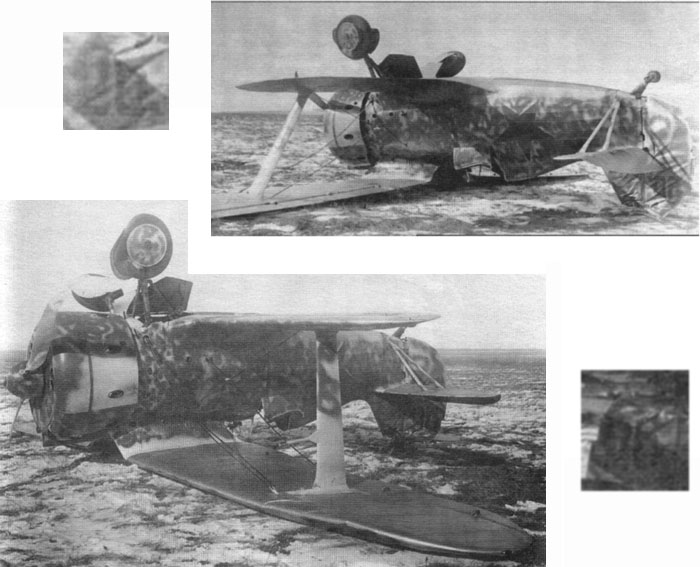
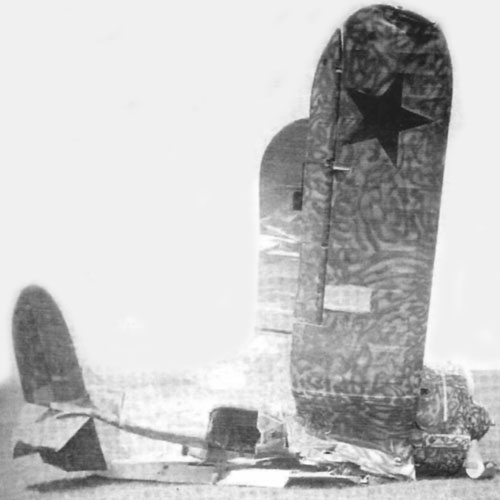 I-153
red 26 of 70th IAP badly landed during the war of 1939 with Japaneses.
The field camouflage with (presumably) green stripes and blotches over
the grey/aluminum background is noteworthy.
I-153
red 26 of 70th IAP badly landed during the war of 1939 with Japaneses.
The field camouflage with (presumably) green stripes and blotches over
the grey/aluminum background is noteworthy.
Right: another plane downed, presumably red 8. Its upper wing pattern, although casual, evidences the circular movement of the arm of the man that painted it while resting on some ladder.
Both planes are of very early production, probably with M-62 engine, and wear different types of spinners: red 8 a wide I-15bis style one, red 26 a smaller type never seen on other images.
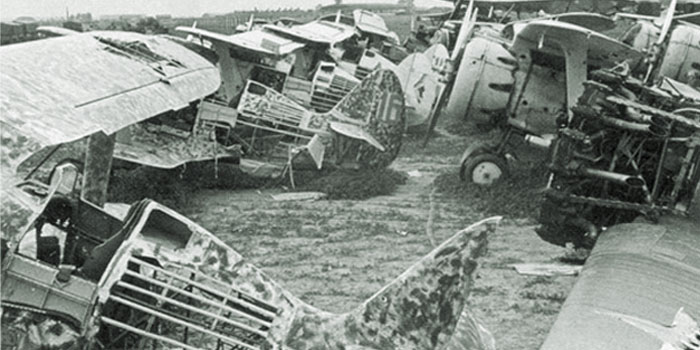

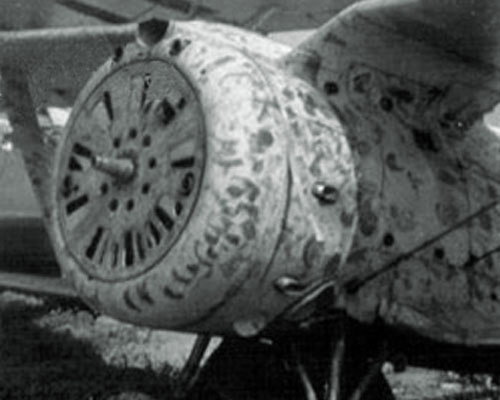 I-153s
captured by Germans on the Minsk airport, 1941.
I-153s
captured by Germans on the Minsk airport, 1941.
Aside silver/grey and green planes, a pair of I-153s (including red 16) look painted with green and black brush strokes.
Someone has suggested that this camouflage could haven't been hurrily painted on at the war outbreak, but that such planes were veterans of the battles against Japaneses.
Right: a detail of one of these planes.
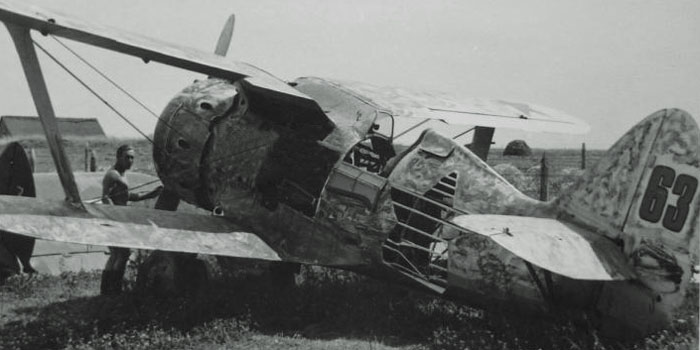
 Left:
the similar 'red 63'. The number is outlined in black.
Left:
the similar 'red 63'. The number is outlined in black.
Right: image of a wrecked I-153 showing the armour seat and other details. The inside color is light, probably light grey AE-9.
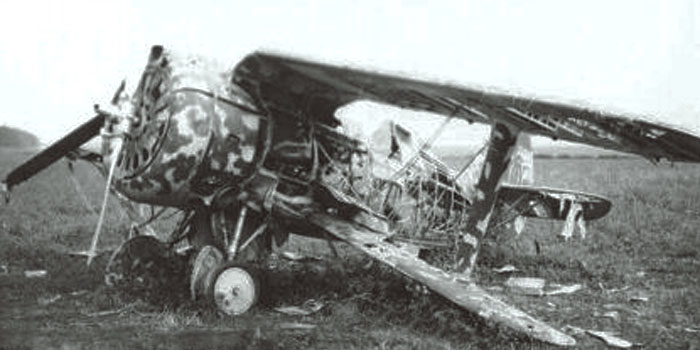
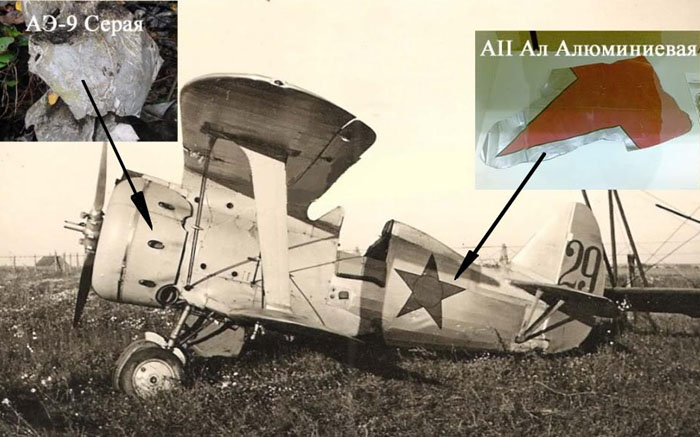
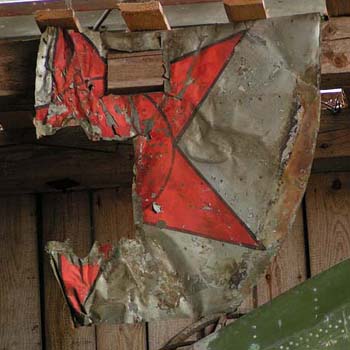 The
standard look for I-153 built till 1940 was: AE-9 light grey on metal-skinned
parts, and AII silver on fabric-skinned parts.
The
standard look for I-153 built till 1940 was: AE-9 light grey on metal-skinned
parts, and AII silver on fabric-skinned parts.
Stating that I-153s were painted (for the most, if not all) with two different colors wasn't banal, and required to examine a wide number of images and some museal exhibits.
On some photos, the difference between colors is not distinguishable; we can't exclude that some I-153 was painted light grey overall.
Right: a piece of fabric from the lower wing of an I-153 preserved in a Finnish museum depot of Vesivehmaa (courtesy Martti Kujansuu)
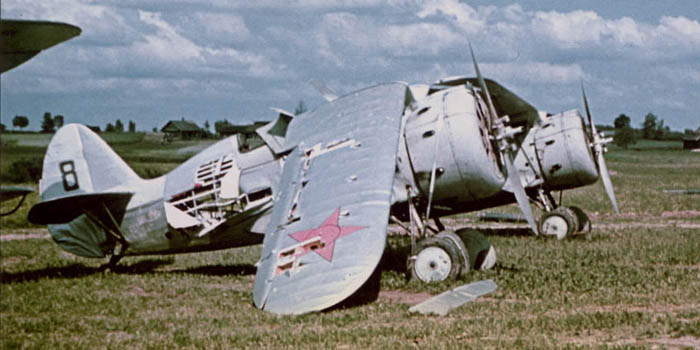
A rare color photo of good quality of I153 during German invasion in 1941. The different shade between silver and light grey is clearly visible.
The lack of the thin pointed spinner visible on late production I-153 let us think that this plane is equipped with M-62 engine.
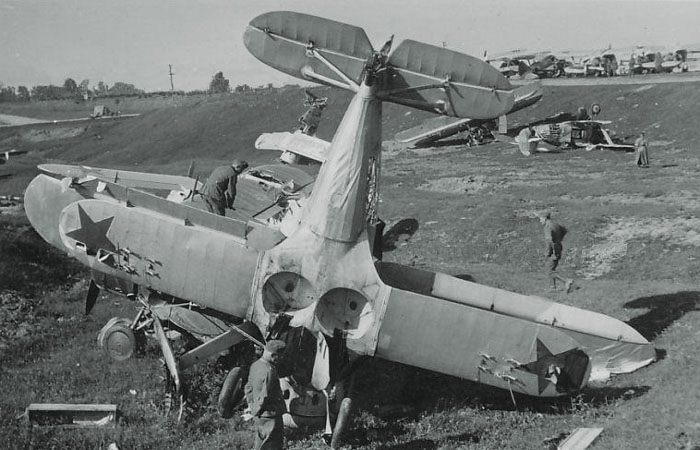
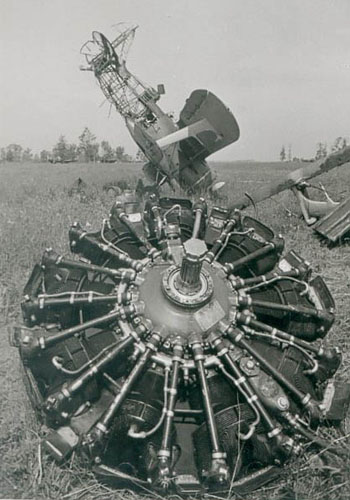 Left:
Left:
This photo, taken near Minsk, shows well the undersurfaces of an I-153. The use of different colors is evident, as the silvery look of the rear fuselage and of the bent wingtip.
Right: an engine M-62 from a wrecked I-153. This engine equipped the most part of the I-153s built.
Due to some technical problems with the more powerful M-63, also a part of the I-153s built in the second half of 1940 were still equipped with this engine as a backup instead of the more advanced one.

Although poor, this image shows an I-153 M-62 with an interesting flash and starlet on the tail. It's difficult to say anything on its color, the red star on the photo could have been retouched.

Red 14 seems an M-62 engined I-153; two bomb racks are visible under each wing.
Note the shape of the smoke traces.
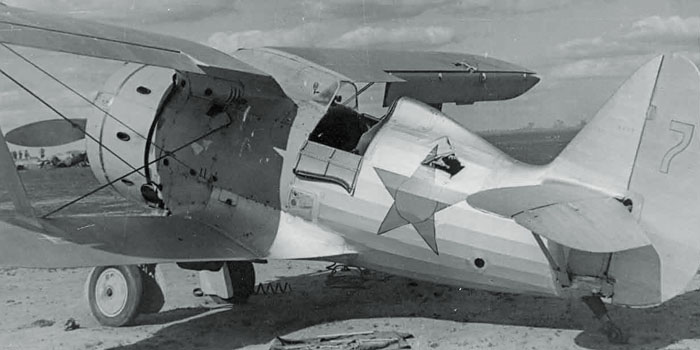
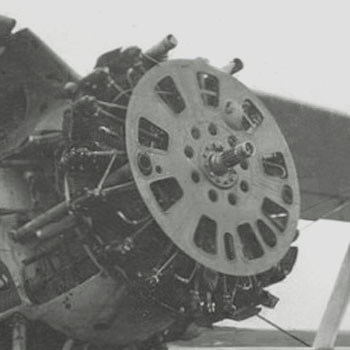 Blue
(?) 7, photographed after having suffered damages during the German
invasion of 1941. The different shade between grey-painted metal parts
and aluminum-painted fabric surfaces is highly evident here.
Blue
(?) 7, photographed after having suffered damages during the German
invasion of 1941. The different shade between grey-painted metal parts
and aluminum-painted fabric surfaces is highly evident here.
Right: a detail of an engine shutters plate of a mid-production M-62 engined I-153. Note the oval hole on the lower left side only.
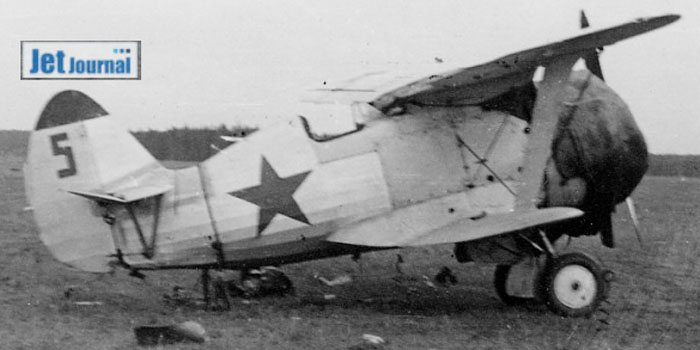
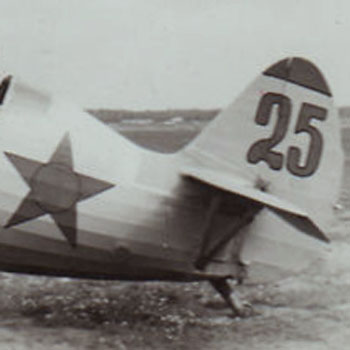 I-153
red (?) 5 captured by Germans at the war outbreak. Noteworthy is the
red (?) flash on the tail.
I-153
red (?) 5 captured by Germans at the war outbreak. Noteworthy is the
red (?) flash on the tail.
(courtesy Jean Konnig)
Left: the tail of another I-153. Note the red number and flash contoured in black.
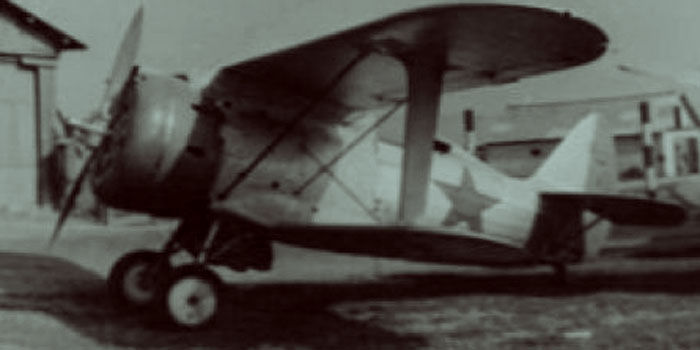
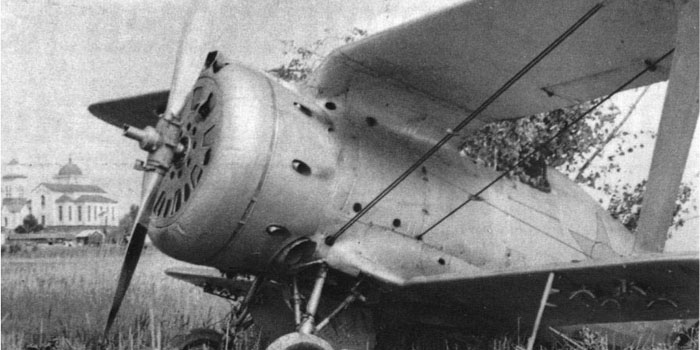

Two images of plane n.12, that appears unusually all painted with silver paint. It was captured by Finns on June 25 1941 at Kerimäki; quickly remarked and repaired, it became VH-19 in Finnish service. All the available photos seem to confirm the overall silver finish.
Note the back of the prop blades partially painted black, and the bomb racks under the wings.
Below: detail of the oil cooler outlet on the left side of the nose of a typical M-62 I-153, with the engine cowling removed. This outlet was absent on later M-63 engined I-153s.


An image of a strange I-153: it would give the idea of the same grey/silver livery of earlier I-153 M-62 with wide green blotches overposed, but the spinner is typical of the later planes with M-63, that were usually painted green and blue.
Unfortunately, no any more informations are available on this plane.
A profile of 'red 29' with similar camouflage can be seen on the monograph of Maslov, but it's an early plane of 56th IAP during the Nomohan war in 1939, with early type propeller and spinner.
The more powerful M-63 engine, able of 1,100 hp at takeoff and 900 hp at altitude, was introduced on production lines in the second half of 1940; 409 planes built with this engine (before the production was stopped at the beginning of 1941.
At the beginning, the M-63 gave heavy problems due to the overheating of the supercharger, so both I-153s and I-16s powered with this engine were grounded in August 1940 for three months; it is likely that the production of M-62 planes was continued as a backup on those months, and that many planes featuring the thin spinner and the late type plate were powered with this old engine.


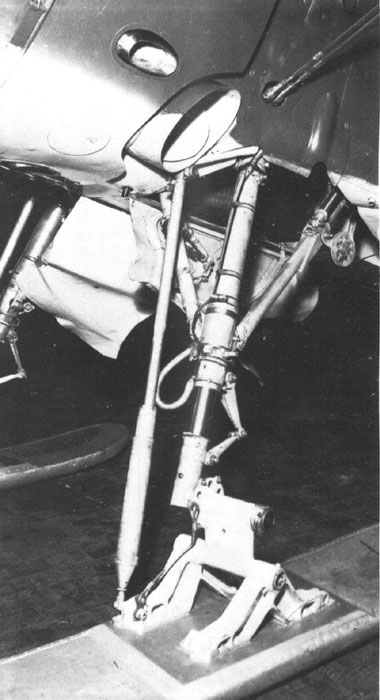 Two
images of an M-63 powered I-153, probably c/n 6931 that was the standard
setter for the production of 1940. The image was probably taken in early
1940, before the type entered in mass production.
Two
images of an M-63 powered I-153, probably c/n 6931 that was the standard
setter for the production of 1940. The image was probably taken in early
1940, before the type entered in mass production.
The new engine required some modifications in the engine cowling:
- the addition of a new cooling window for the larger oil cooler on the lower right part of the nose; in this plane the window has an oval shape as the one on the left side (already appeared on M-62 engined planes)
- the outlet of the oil cooler was removed from the left side, in front of the wing root, and moved under the cowling, that was a bit wider in its lower side and with an asymmetrical rear cutout for the hot air outlet; see the photo above of the same plane.

The plane is equipped with a retractable ski gear. The wheel bays were partially closed by plates, leaving only a rectangular window for the ski joints; the ski itself adhered externally to the fuselage.
Right; a detail of the typical air outlet of the oil cooler of M-62 powered planes, deleted on M-63 engined ones. The leg and ski joints are well visible.
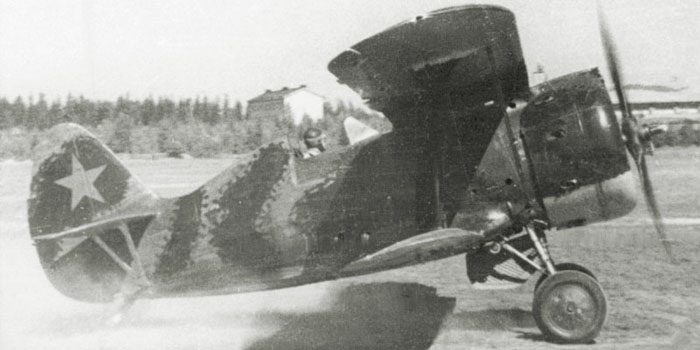
Another strangely painted I-153 of 7th IAP, Leningrad 1941: it looks that the metallic parts have an usual green/black camo, while the fabric-covered part could be only a bit passed with green strokes on the silver surface. Black bands with dotted outline break the plane's shape.
The cutout under the engine cowling rear identifies it as an M-63 engined plane.
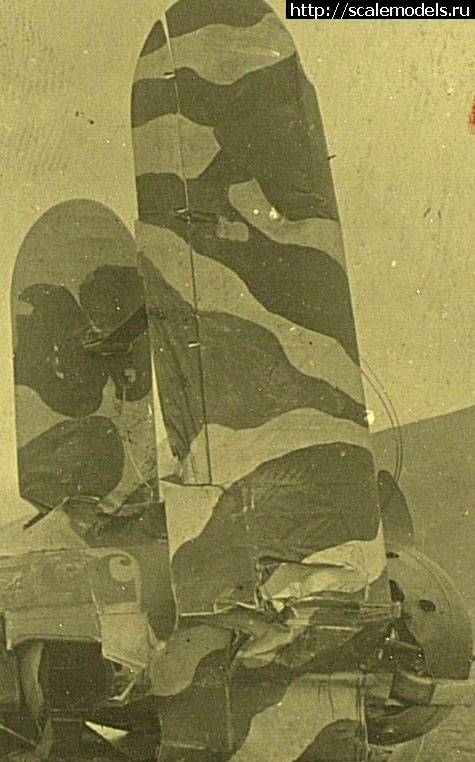
A most interesting camouflage is shown on this photo of 'red 552', the number being visible on the fuselage sides.
it looks made with blotches and bands of at least two colors, probably dark green and black, probably on the base of the original silver/grey livery. The red stars on the upper wing surfaces were deleted. It's possible, but unlikely unlikely that a red star was applied on the rudder, because the plane, despite the new camouflage, was still much visible from above.
I-153s built after June 1940 conformed to a new standard of painting:
 AII gloss camouflage green for upper surfaces
AII gloss camouflage green for upper surfaces
 AII light blue for undersurfaces.
AII light blue for undersurfaces.
Some transition planes seem to have preserved the old-fashioned grey-silver finish for the undersurfaces, that sometimes appear disomogeneous in photos.
On the right: an interesting color photo of unknown origin and date. The plane seems to have been repainted, because the green on the cowling and wings struts is more extended than on the typical factory livery visible on the photos below.

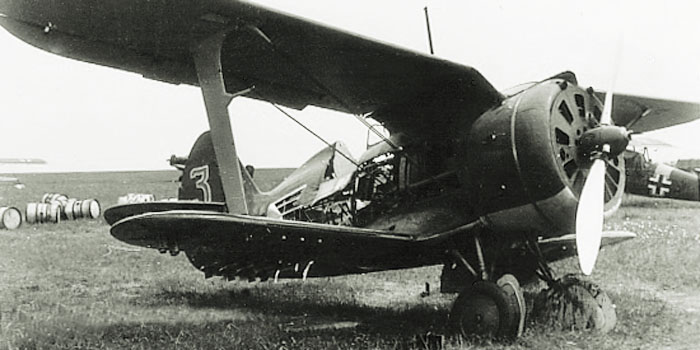
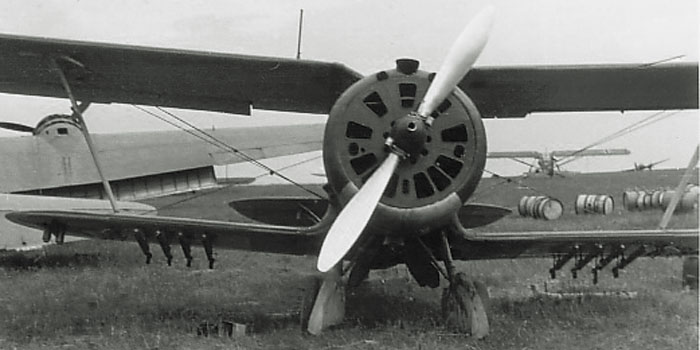
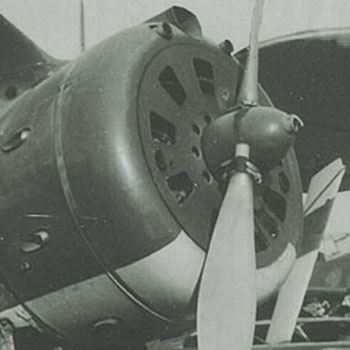 Typical
I-153s built in this period (both M-62 engined and M-63 engined) were
painted in the AII green/AII light blue scheme.
Typical
I-153s built in this period (both M-62 engined and M-63 engined) were
painted in the AII green/AII light blue scheme.
Two photos of a late plane captured by Germans during Operation Barbarossa. The fabric skin on the fuselage sides looks vandalized by German souvenir hunters that have removed the star.
The engine shutters plate, here with the shutters rotated in fully open position, has more openings than on previous variants; the additional windows for the oil cooler of the M-63 engine became trapezoidal, not longer oval, on production planes.
On the right, we see the the plate of a M-62-engined I-153 that has one window less than the plane on the left, and a smaller and oval window on its lower left. Probably this old plate was compatible with the M-62 only, due to its smaller oil cooler, but it seems that the M-63 style plate was utilized for new-built planes with the older M-62 too.
It's hard to say if the plane represented on those photos was delivered by factory in the new livery, or repainted green on its upper surfaces only when already delivered to the unit. The color of the lower wing undersurface looks to change, this suggests grey/silver undersurfaces or a partial repainting of the wings with AII light blue.
 Note
four rockets rails plus one bomb rack under each wing, and the rare
radio mast over the right upper wing. One can be vaguely see the metal
panels added to protect the wings undersurfaces against the fire of
the rockets .
Note
four rockets rails plus one bomb rack under each wing, and the rare
radio mast over the right upper wing. One can be vaguely see the metal
panels added to protect the wings undersurfaces against the fire of
the rockets .
The night landing torches are protruding under its lower right wingtip; in flight they were retracted inside the wing and can be extracted through small doors.
Right: detail of the rockets on another I-153. This type could carry both 3 or 4 rockets rails under each wing.
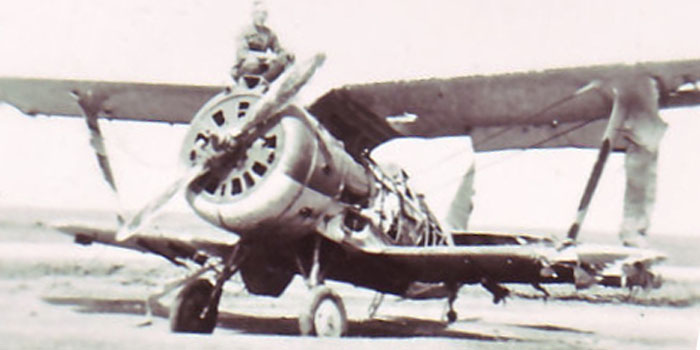
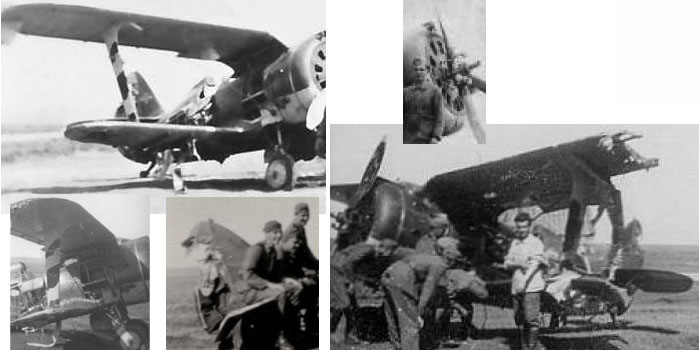
Photos of an unusual I-153:
The lack of the side air outlet identifies it as an M-63 engined plane.
The plate is the type with more windows as on late 1-153, but the propeller is without the thin spinner that characterizes the late production planes.
It has the green/light blue livery introduced in June 1940, but its propeller and wing struts are crudely painted with black stripes. A black dot seems visible on the right side of the nose too (unclear if it has to do with the nearby exhaust pipe).
Only two rails for RS-82 rockets are visible under each wing.
It's difficult to say anything about any number on the tail; from one photo, it seems to be a wide white 3 (?) on the right side of the rudder, but this is not visible on the left side.
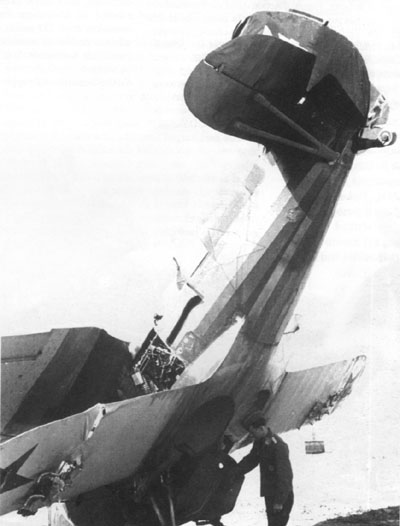
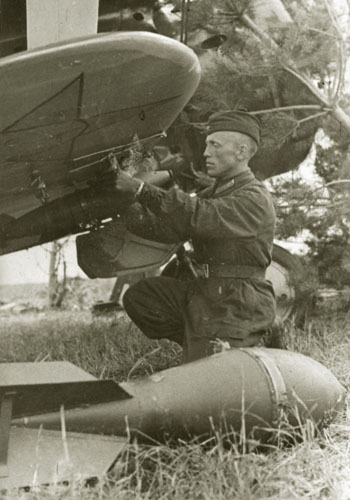 Another
I-153 with green upper surfaces. The rear fuselage and tail undersurface
looks still painted in silver, while the wings seem partially brush
repainted with AII light grey or AII light blue; the metallic parts
of the fuselage undersurface looks to have preserved the old, weathered
AE-9 finish that appears darker in this image.
Another
I-153 with green upper surfaces. The rear fuselage and tail undersurface
looks still painted in silver, while the wings seem partially brush
repainted with AII light grey or AII light blue; the metallic parts
of the fuselage undersurface looks to have preserved the old, weathered
AE-9 finish that appears darker in this image.
Right: a technician crew is loading bombs under an I-153. The plane a could carry up to 4 bombs of 150 kg each.
The thin bomb already loaded is an AO-25 of 25 kg, while the drop-shaped bomb on the ground is a FAB-50SV of 50 kg, introduced in 1937.
Soviet bombs were usually painted with a medium grey color.
http://sovietwarplanes.com/board/index.php?topic=1086.30
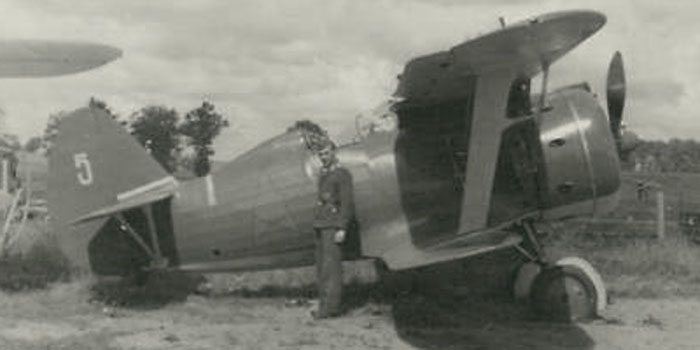
Late plane captured by Germans. The painting looks in AII green on the upper an side surfaces, and AII light blue on undersurfaces, that don't show any metallic reflection.
Note the thin white (?) lines on the tail, perhaps a sealing with adhesive tape to flush the metallic plate at the base of the stabilizer.
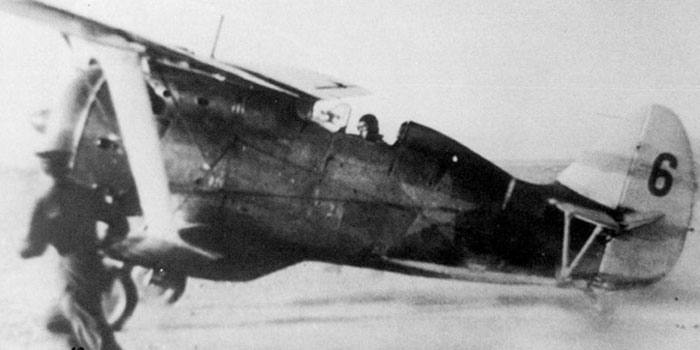
Late I-153 (recognizable for the thin spinner and the radio mast).
This plane was often described as of 72 SAP (mixed regiment) VVS SF at Vaenga-1 airbase in summer 1941, but another photo of it from another perspective shows mountains on the background, not existing in Vaenga.
An alternative proposed attribution is of 8 iap of Black Sea Fleet, Kacha.
The plane features a white or silver tail (if so, it could be a replacement from a silver-grey plane) with a 6 painted in unknown color, possibly red. The lower part of the rudder is painted with an unidentified color (it's not the shadow of the struts).
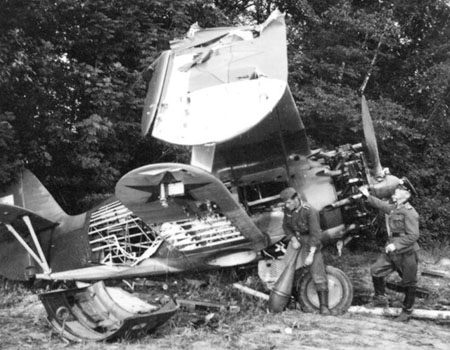
A wrecked I-153 examined by Germans. The soldier holds a FAB-50 bomb.
The upper wing has some parts of light skinning (silver or white) on it; it's unclear if this is due to a painting or, more likely, a repair with new fabric.

White 19 of 13 IAP-KBF, flown by lt.Ovchinnikov, was hit by AA fire and landed on Finnish ground. The plane was later repaired by Finns and became IT-20.
The painting is unusual: despite having the spinner suggesting that it's a late production plane, it was delivered with the grey-aluminum livery, and roughly brush painted with green.
The front plate looks painted with solid green, darker than the cowling.
(image from Avions n.169)
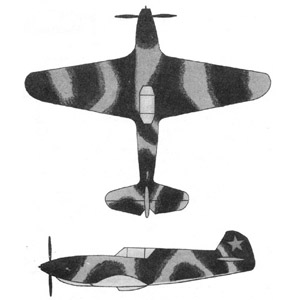 On
20 June 1941, the last day of peace, it was published an order of NKAP
(the Ministry for Aeronautical Industry) to paint all planes with a
new standard camouflage within one month.
On
20 June 1941, the last day of peace, it was published an order of NKAP
(the Ministry for Aeronautical Industry) to paint all planes with a
new standard camouflage within one month.
For newly built planes, the instructions said to utilize matt light blue for undersurfaces (not specified what type of paint, but all previous light blue paintings were gloss, so they have to be A-28m for all-metal planes and AMT-7 for mixed construction planes).
Apart for some Yaks, the first known photos of planes with the new green/black painting scheme are dated to July 13, 1941.
Many maintenance manuals of the first years of war describe these paints: dope AMT-4 green, AMT-6 black and AMT-7 blue enamel or oil A-24m, A-26m and A-28m of the same colors. Oil colors were less utilized, also because AMT colors can adhere well to primed metal surfaces.
Despite their name (M= matt), AMT colors were semigloss when new, and turned to matt finish with ageing. Occasionally, they could have been overpainted with a layer of gloss varnish AB-4-d to improve aerodinamicity and gain some speed.
While AMT-4 and 6 were codified in July 1941, AMT-7 was codified in August 1941, and is not mentioned on earlier manuals; earlier AII light blue remained in use in parallel with the darker AMT-7 in the first years of war.
Oil enamels were intended to be sprayed on the exterior metal surfaces, even unprimed. Painting with a brush meant poor paint properties, and was allowed only as a second choice, ex. for repairs.
Prop blades were now fully painted black.
The order of June 1941 changed the national marks of planes too. Red stars, of plan type or with thin black outline, were now placed in four or six positions:
- one on each side of fuselage (not always),
- one on each side of rudder/stabilizer,
- one on the undersurface of each wing (lower wing, in case of biplanes).
Note the deletion of stars over the wings, and the introduction of new ones on the tail.
The release of a clear directive on camouflaging the planes with green and black bands, with light blue undersurfaces, reached the units contemporarily with the war outbreak, when the frontline units had other things to worry about.
The directive previded that the existing planes, already painted with a layer of green on upper surfaces (both AII green, A-19f or earlier types of protective), had to be painted with black bands, eventually preserving the original green and the original color of undersurfaces.
Many Soviet planes still had light grey and/or aluminum liveries; theorically, they had to be repainted with green/black upper surfaces, eventually leaving the original silver/grey color on undersurfaces.
The lack of time and of paint sometimes led to improvised camouflages, made by spraying or brushing green and, eventually, black strokes on the upper and side surfaces of silver/grey planes; these were not intended as experimental camouflages or due to artistic inventive of some technicians, but as improvisations intended to spare paint and time. This use was not exclusive of the first days of war; already in July 1939, SB and I-153s employed in the Khalinin-Gol conflict against Japaneses were camouflaged with green serpentines over the silver/grey original finish.
Probably, these camouflages were made utilizing existing stocks of pre-war paints, even if it could be that, in some cases, they could have employed newer AMT or A-xx m paints.
The red stars on the upper face of wings were usually obliterated with camo colors, and new stars were added on the sides of the tail in addition to those on the fuselage.
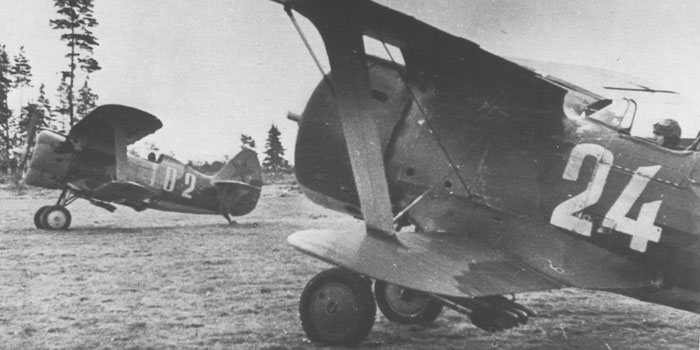

Planes of 71 IAP-KBF at Lavansaari Island in the Gulf of Finland in August 1942.
They look to wear a black-green camouflage with different patterns.
The plane n.102 is flown by Major Biskup, while n.24 by the squadron leader Captain K.V. Solovyak. The side exhaust close to the wingroot seem to identify it as M-62 engined.
Below: another image of 102, whose front plate is of late type, typical of M-63 engined planes. It seems that this plate became of general use on late-built I-153s.
(from Wydawnictwo Militaria n.222, Polikarpow I-153 of Maslov)

The look of 1-153s utilized as ground attack planes in late 1941/42 is characteristic:
- black-green camouflage, often obtained by overpainting the old livery with gloss black paint with non-standardized pattern;
- 6 or 8 RS-82 rocket rails under the wings, often aside one bomb rack; the wings undersurfaces were protected against the fire of the rockets by the installation of thin metal plates;
- deletion of the landing gear doors to save weight;
- sometimes, deletion of the engine shutters plate and of the spinner;
- two-digit white numbers on the fuselage sides;
- red stars (probably of the plain type) on the fuselage sides and/or on the tail, and on lower wing surface.
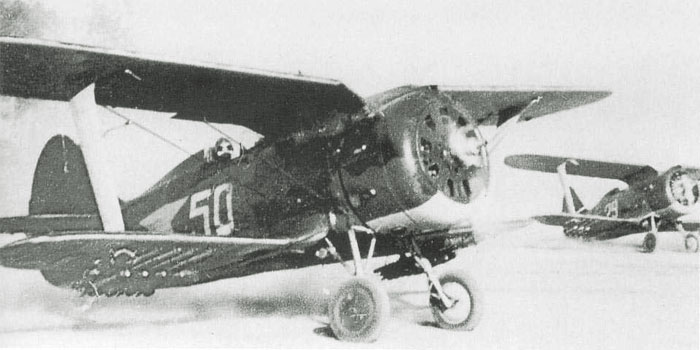
I-153s of 71 IAP in August 1942.
Plane white 50 was flown by Capt.A.G.Baturin,that was later awarded with the Golden Star, having a score of nine victories. The plane has four rocket rails plus one bomb rack under each wing; plane n.29 has three rockets only and one bomb rail.
The upper camouflage appear gloss; it could have been obtained by partially overpainting the old AII green livery with gloss black.
Plane n.29 is without the front shutters plate, leaving the engine visible.

I-153 perhaps of 71 IAP as on previous photos. The large side outlet is typical of M-62 engined planes, even if the front plate is of late type.


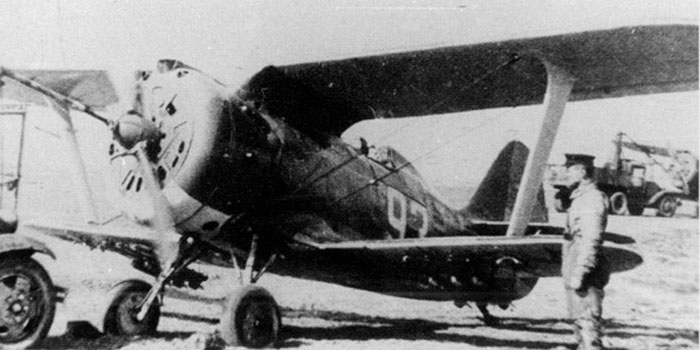
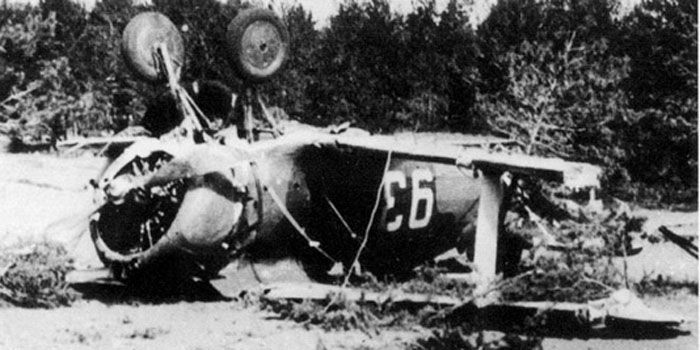
Three images of I-153 white 93 of the 71 IAP VVS KBF in August 1942.
The first and second photos show three rocket RS-82 plus one bomb rack under each wing.
It's not clear if the third image is of the same plane: the crashed one lacks of the spinner, of the engine shutter and of the under wing rocket rails; on the other hand, the profile of the black band under the bort number is surprisingly similar to that of the first photo, but the star isn't visible, perhaps for a joke of the film. It could be the same plane after having lightened of all what was possible.
Note that one bomb rack under each wing was often preserved even after the installation of rocket rails.
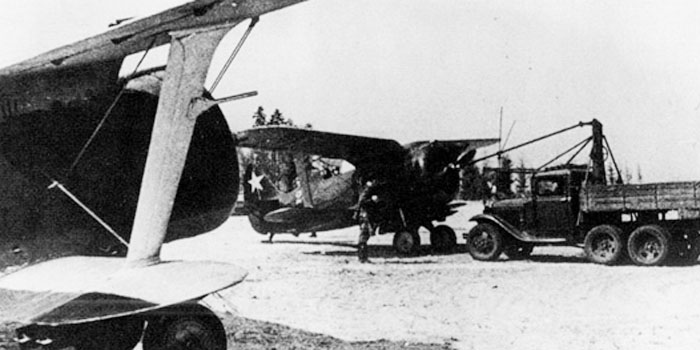
Camouflaged I-153s of 7 IAP of the Baltic fleet.
The closest plane shows that only the rear part of its wing was repainted, while the front part looks to have been left in its original silver finish.
Note the strange position of the number 2 on the plane that is being started by the truck.
(From Polikarpov fighters in action-Squadron Signal)
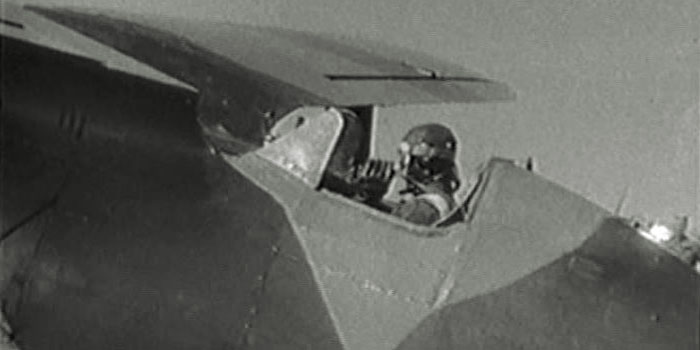
This image is from a movie on the Moscow PVO made in 1943. The camouflage of this plane, as that of three MiG-3 and of one I-16 appearing in that movie, is sharp and strongly contrasted. Probably the plane was fully repainted with AMT-4/6 paints.
http://scalemodels.ru/modules/forum/viewtopic_t_6048_start_320.html

The usual factory grey/aluminum finish of I-153s was often mistakenly considered a winter camouflage.
This photo of 2 December 1941 seems to be the only available that shows an I-153 painted with a real winter scheme made with MK-7 washable white distemper. Note the different color of the undersurface of the fuselage.